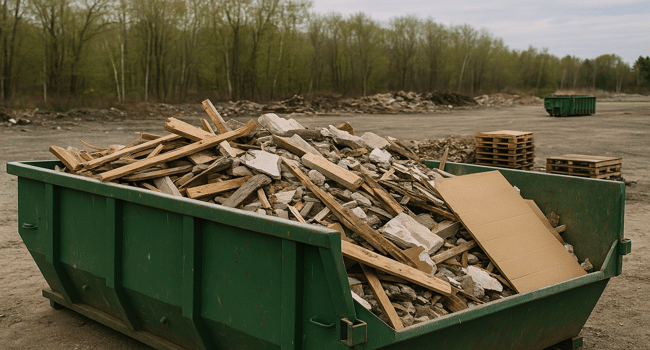Table of Contents
Most human beings consider particles elimination as a remember of comfort. When a room gets renovated, a constructing is torn down, or the garage receives a protracted-late cleaning, a container suggests up, the junk is going in, and it disappears. Out of sight, out of thoughts.
But where that debris finally ends up—and how it’s handled—has an impact a long way more than just keeping your own home tidy. Proper waste control performs a quiet however crucial position in protecting ecosystems, keeping herbal resources, and decreasing the footprint of our creation and patron conduct.
What regularly is going ignored is that every desire we make in the course of the disposal technique—whether or not we select to recycle, whether or not materials are separated, whether we use a responsible dumpster rental business enterprise—has a ripple impact. And the dimensions of that ripple relies upon totally on how we plan for it.
The Environmental Risks of Poor Disposal
When particles is left to accumulate or disposed of carelessly, it doesn’t just muddle job sites or neighborhoods—it becomes a contributor to land and water pollution. Construction sites, especially, can generate widespread environmental dangers while unmanaged substances leach into the ground or wash into close by drains.
Proper production particles elimination is going past throwing waste into a bin. It consists of sorting recyclable materials like metallic, wooden, and concrete so that they may be diverted from landfills. It way warding off contamination via keeping apart hazardous or regulated gadgets. And it approach scheduling well timed removal to save you erosion, runoff, and publicity.
Unlocking the Value of Recyclable Debris
Too frequently, treasured materials are wasted due to the fact disposal was rushed or unsorted. Consider this: wood scraps from framing, if separated correctly, can be ground into mulch or biofuel. Crushed concrete may be reused as road base. Even drywall can on occasion be recycled into new constructing products. When these gadgets are mixed with non-recyclables or tossed without consideration, all of that ability is misplaced.
That’s why gaining access to the proper gear—which includes a properly-timed rolloff carrier—is more than only a logistical convenience. It permits right coping with at the source, where sorting and method make the biggest effect. When containers are to be had as needed and placed strategically, it becomes less difficult for contractors and owners to preserve recyclables clean and become independent from general waste.
Everyday Opportunities for Waste Diversion
This isn’t always pretty much large-scale creation tasks. Even home renovations generate substances that could be salvaged or recycled if controlled thoughtfully. Old shelves, floors, furnishings, and metallic hardware—while stored dry and intact—have possibilities for reuse that reduce the strain on landfills.
Of direction, it’s no longer continually possible to recycle the entirety, in particular during massive demolitions or whilst timelines are tight. But even partial diversion subjects. Each ton of debris stored out of the landfill reduces methane emissions, lessens soil infection, and conserves space in waste facilities already nearing capacity.
Building a Culture of Responsibility
More importantly, it sets a wellknown. When contractors, assets proprietors, and residents make seen efforts to control waste responsibly, it builds a lifestyle of sustainability that others comply with. It normalizes the concept that particles isn’t “trash”—it’s a useful resource that may be controlled with cause.
Supporting Smarter Waste Strategies
At Hiep Sanitation, Those considerations are part of the each day habitual. While the number one carrier is the elimination of waste, the extra project is to support accountable practices. That consists of advising customers on what can be recycled, when to schedule pickups to prevent overflow, and how to decrease environmental impact with out disrupting timelines.
In groups that undertake this attitude, the outcomes come to be tangible. Cleaner process sites, fewer overflowing bins, reduced instances of illegal dumping, and stepped forward air and water satisfactory. It’s a long-term funding that begins with a unmarried decision: how do we treat the waste we create?
Urban Planning and Policy Impact
It also ties back to urban planning and development. Cities that combine sustainable particles management into their regulations often see fee savings in public works and health departments. Fewer fines, much less emergency cleanup, and decreased stress on stormwater systems all start with proper disposal planning.
Resource Conservation and Global Reach
There’s additionally a resource conservation attitude. The extra we recycle, the much less raw fabric we need to extract. That method fewer forests reduce, fewer mountains mined, and fewer rivers altered for fabric harvesting. What begins as a habitual dumpster apartment or rolloff carrier finally ends up maintaining landscapes miles faraway from the job web page.
Even citizens gain. Properties with clean, responsibly maintained surroundings revel in higher visual attraction, higher air nice, and a stronger experience of delight among neighbors. And whilst humans see packing containers dealt with nicely and substances looked after, they’re more likely to replicate those behaviors at domestic.
Conclusion: Small Choices, Big Impact
In many methods, the future of sustainability won’t be pushed with the aid of flashy improvements—however by using thoughtful, normal alternatives. How we put off waste is one of those picks. It’s not glamorous, however it’s effective.
Proper debris elimination won’t get headlines, but its impact is woven into the very environments we depend on. The cleanser our disposal behavior, the purifier our groups—and the greater resilient our ecosystems come to be.
That’s why partnering with providers like Hiep Sanitation, who recognize the value of timing, sorting, and stewardship, can remodel greater than simply the appearance of a process site. It contributes to a legacy of sustainability that maintains long after the ultimate load is hauled away.
Because in the end, how we treat our waste says plenty about how we treat the arena round us.
Read more on KulFiy
